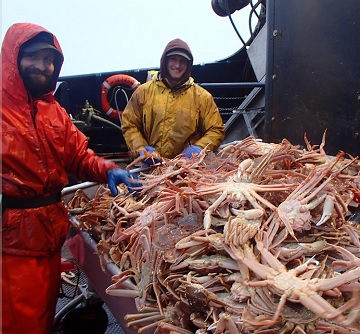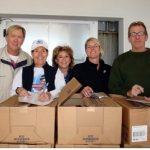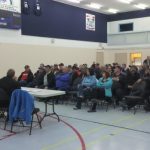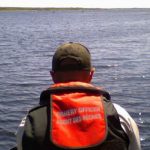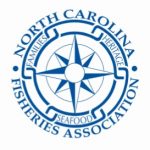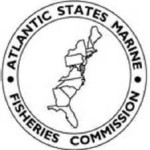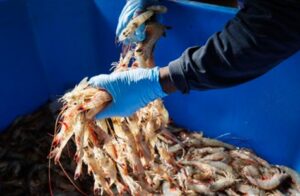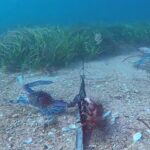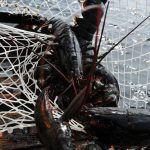Tag Archives: Bering Sea
Bering Sea snow crab season kicks off for first time in three years
 Earlier this month, commercial snow crabs started hitting Unalaska’s docks again, for the first time in nearly three years. The Bering Sea snow crab fishery reopened in mid-October, after billions of the crab disappeared and the fishery was shut down in October 2022. This season’s first catch was delivered on Jan. 15. Opilio, or snow crab, is generally fished in the new year and into the early spring. The season runs through May. Alaska Department of Fish and Game Area Management Biologist Ethan Nichols said nine vessels are actively participating in the Bering Sea commercial fishery. “The fleet is just getting started, for the most part,” Nichols said. “Fishing so far — the reports from the grounds — there seems to be good numbers of nice, new shell, large snow crab on the far northern portions of the grounds.” more, >>CLICK TO READ<< 15:06
Earlier this month, commercial snow crabs started hitting Unalaska’s docks again, for the first time in nearly three years. The Bering Sea snow crab fishery reopened in mid-October, after billions of the crab disappeared and the fishery was shut down in October 2022. This season’s first catch was delivered on Jan. 15. Opilio, or snow crab, is generally fished in the new year and into the early spring. The season runs through May. Alaska Department of Fish and Game Area Management Biologist Ethan Nichols said nine vessels are actively participating in the Bering Sea commercial fishery. “The fleet is just getting started, for the most part,” Nichols said. “Fishing so far — the reports from the grounds — there seems to be good numbers of nice, new shell, large snow crab on the far northern portions of the grounds.” more, >>CLICK TO READ<< 15:06
From fish traps to factory trawlers — A ‘back to the future’ look at Seattle’s fishing industry
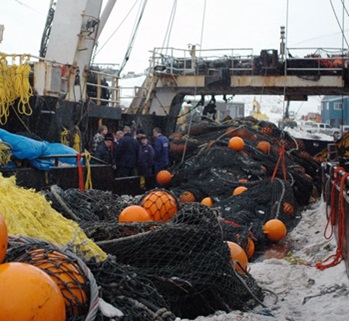 An advertiser-sponsored article in the Seattle Times gushed “Wild Alaska pollock’s fishing fleet is based right here in Seattle although all of the fish are caught in U.S. waters off of the coast of Alaska. This fishery benefits the economic growth of the entire region, including the North Pacific Fishing Fleet.” That includes 300 commercial fishing vessels of which 226 fish in Alaska. Many of the boats are huge catcher-processors — factory trawlers — that target pollock, cod, rockfish, flounders and other “groundfish” species. Alaska pollock alone is a 3 billion-pound fishery worth roughly $2 billion. And every year, the Seattle trawlers take home up to 76% of the value of ALL groundfish caught in the Bering Sea and Gulf of Alaska. It’s not a new scenario. Starting in 1885 and until Alaska became a state in 1959, Seattle companies used big traps to catch salmon throughout the territory. more, >>CLICK TO READ<< 10:55 By Laine Welch
An advertiser-sponsored article in the Seattle Times gushed “Wild Alaska pollock’s fishing fleet is based right here in Seattle although all of the fish are caught in U.S. waters off of the coast of Alaska. This fishery benefits the economic growth of the entire region, including the North Pacific Fishing Fleet.” That includes 300 commercial fishing vessels of which 226 fish in Alaska. Many of the boats are huge catcher-processors — factory trawlers — that target pollock, cod, rockfish, flounders and other “groundfish” species. Alaska pollock alone is a 3 billion-pound fishery worth roughly $2 billion. And every year, the Seattle trawlers take home up to 76% of the value of ALL groundfish caught in the Bering Sea and Gulf of Alaska. It’s not a new scenario. Starting in 1885 and until Alaska became a state in 1959, Seattle companies used big traps to catch salmon throughout the territory. more, >>CLICK TO READ<< 10:55 By Laine Welch
Red king crab harvest looking ‘very good’ so far for Bristol Bay fleet
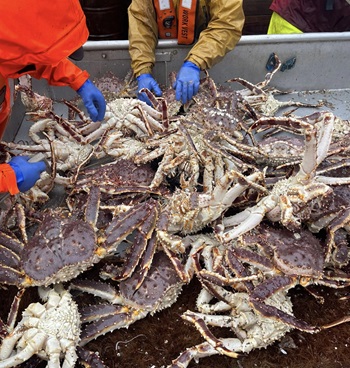 The Bering Sea’s biggest and most lucrative crab fisheries opened last week, and so far, fishing is looking good. “Fishing has been very good for the [Bristol Bay red king crab] fleet this season and the crab delivered so far has been of high quality — new shell, large size, good meat-fill,” said Alaska Department of Fish and Game Area Management Biologist Ethan Nichols. As of Wednesday afternoon, about 29% of the total allowable catch (TAC), for the Bristol Bay red king crab fishery had been harvested, according to Nichols. He said so far, reports from captains and from observer catch reports show signs of productive fishing. Nichols said 14 vessels had landed about 680,000 pounds of king crab. The average weight is 6.84 pounds, and the catch rate is 35 legal males per pot. Both of those numbers are up slightly from last year. more, >>CLICK TO READ<< 09:14
The Bering Sea’s biggest and most lucrative crab fisheries opened last week, and so far, fishing is looking good. “Fishing has been very good for the [Bristol Bay red king crab] fleet this season and the crab delivered so far has been of high quality — new shell, large size, good meat-fill,” said Alaska Department of Fish and Game Area Management Biologist Ethan Nichols. As of Wednesday afternoon, about 29% of the total allowable catch (TAC), for the Bristol Bay red king crab fishery had been harvested, according to Nichols. He said so far, reports from captains and from observer catch reports show signs of productive fishing. Nichols said 14 vessels had landed about 680,000 pounds of king crab. The average weight is 6.84 pounds, and the catch rate is 35 legal males per pot. Both of those numbers are up slightly from last year. more, >>CLICK TO READ<< 09:14
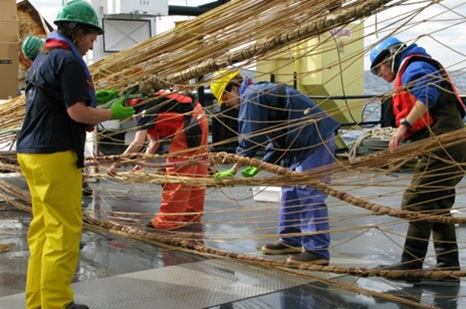
Multiple groups urge seafloor protections from pelagic trawling
A diverse group of harvesters, conservation entities and others are calling on federal fisheries managers to do more to protect seafloor habitats from midwater trawl nets they say are dragging the bottom of the ocean floor. Midwater, or pelagic trawling — used to catch schooling fish like pollock, is supposed to be fished in the water column rather than on the seafloor. For this reason, pelagic trawling is allowed in most conservation areas closed to bottom trawling — a form of fishing where nets are purposely dragged on the seafloor and damage corals, sponges and other living seafloor habitats in the process. An analysis by the National Marine Fisheries Service indicates that 40% to 100% of the width of pelagic trawl gear fished in the Gulf of Alaska and Bering Sea has been in contact with the seafloor, and that these nets, which range from 50 to 190 yards wide, are dragged for miles. more, >>CLICK TO READ<< 20:12
Tribal groups, seeking restrictions on Alaska’s Bering Sea trawlers, get day in court
 U.S. District Court Judge Sharon Gleason heard oral arguments Thursday in a lawsuit filed by two of Alaska’s largest tribal groups against federal managers of the state’s groundfish trawl fisheries. The Association of Village Council Presidents and the Tanana Chiefs Conference claim the federal government has failed to adjust trawling rules in the Bering Sea and off the Aleutian Islands to compensate for the ongoing salmon crisis on Alaska’s Interior rivers. Victory by the plaintiffs could lead to new restrictions on the world’s largest trawl fishery. If plaintiffs lose, the status quo is likely to continue. On Thursday, Gleason asked plaintiffs whether they’re seeking a halt to trawl fishing in the Bering Sea. No, the plaintiffs said. more, >>CLICK TO READ<< 11:27
U.S. District Court Judge Sharon Gleason heard oral arguments Thursday in a lawsuit filed by two of Alaska’s largest tribal groups against federal managers of the state’s groundfish trawl fisheries. The Association of Village Council Presidents and the Tanana Chiefs Conference claim the federal government has failed to adjust trawling rules in the Bering Sea and off the Aleutian Islands to compensate for the ongoing salmon crisis on Alaska’s Interior rivers. Victory by the plaintiffs could lead to new restrictions on the world’s largest trawl fishery. If plaintiffs lose, the status quo is likely to continue. On Thursday, Gleason asked plaintiffs whether they’re seeking a halt to trawl fishing in the Bering Sea. No, the plaintiffs said. more, >>CLICK TO READ<< 11:27
An Unlikely Sea Animal Saved F/V Time Bandit’s ‘Deadliest Catch’ Season
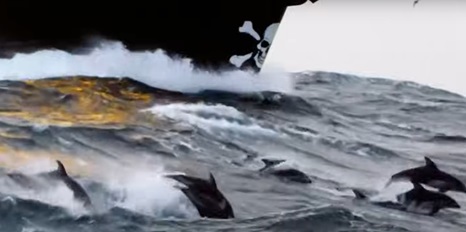 Aboard F/V Time Bandit, Captain Johnathan Hillstrand was struggling. For each Captain, a profitable trip out in the Bering Sea is determined by the catch they bring in. For one journey, it seemed the Time Bandit would return to the dock virtually empty-handed. Captain Jonathan Hillstrand was a bit dejected as this recent trip was seemingly like a bust. Having been out at sea for years, working as a crabber, he had been no stranger to dismal catches. But despite any hope and positivity, unless a miracle was about to happen, it would be just another failure on the list. With only hours to go before reaching the harbor, 250 miles away, Captain Johnathan encountered a miracle. In a scene almost straight out of a movie, he saw some dolphins swimming around the ship. The crew knew that wherever they were heading, there were bound to be some crabs lurking. Because the dolphins would be attracted to the bait like the crabs, it might be a prosperous moment after all. Photos, Video, more, >>CLICK TO READ<< 11:39
Aboard F/V Time Bandit, Captain Johnathan Hillstrand was struggling. For each Captain, a profitable trip out in the Bering Sea is determined by the catch they bring in. For one journey, it seemed the Time Bandit would return to the dock virtually empty-handed. Captain Jonathan Hillstrand was a bit dejected as this recent trip was seemingly like a bust. Having been out at sea for years, working as a crabber, he had been no stranger to dismal catches. But despite any hope and positivity, unless a miracle was about to happen, it would be just another failure on the list. With only hours to go before reaching the harbor, 250 miles away, Captain Johnathan encountered a miracle. In a scene almost straight out of a movie, he saw some dolphins swimming around the ship. The crew knew that wherever they were heading, there were bound to be some crabs lurking. Because the dolphins would be attracted to the bait like the crabs, it might be a prosperous moment after all. Photos, Video, more, >>CLICK TO READ<< 11:39
The Snow Crab Collapse: A Tale of Unproven Assumptions and Overlooked Explanations
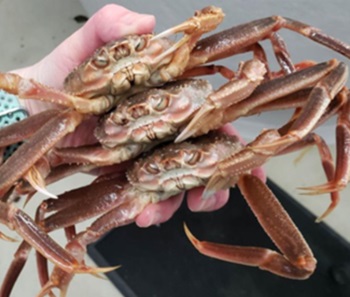 The sudden decline in the snow crab population in the Bering Sea has triggered considerable concern among scientists, fisheries, and environmentalists alike. The collapse is alarming not only because of its immediate economic impact but also due to the broader implications for marine ecosystems. However, a critical examination of the prevailing explanations for this phenomenon reveals a troubling reliance on speculation rather than solid evidence. The central thesis of the NOAA Fisheries report—that warmer water temperatures increased snow crab metabolism, leading to their downfall—requires a more skeptical analysis. In this post, we’ll explore the weaknesses of this hypothesis, examine other plausible causes, and argue for a more comprehensive approach to understanding this ecological mystery. more, >>CLICK TO READ<< 08:27
The sudden decline in the snow crab population in the Bering Sea has triggered considerable concern among scientists, fisheries, and environmentalists alike. The collapse is alarming not only because of its immediate economic impact but also due to the broader implications for marine ecosystems. However, a critical examination of the prevailing explanations for this phenomenon reveals a troubling reliance on speculation rather than solid evidence. The central thesis of the NOAA Fisheries report—that warmer water temperatures increased snow crab metabolism, leading to their downfall—requires a more skeptical analysis. In this post, we’ll explore the weaknesses of this hypothesis, examine other plausible causes, and argue for a more comprehensive approach to understanding this ecological mystery. more, >>CLICK TO READ<< 08:27
Gulf of Alaska trawl pollock vessels to be included in electronic monitoring program
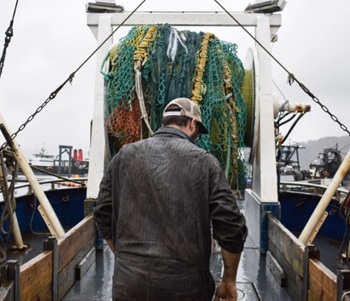 According to the 2023 annual report from the North Pacific Observer Program, the vast majority of groundfish harvest in Alaska is observed with full coverage, meaning 100% of all trips are monitored by either onboard observers or electronic monitoring. After years of testing the program, electronic monitoring will soon be expanded to include pelagic trawl pollock catcher vessels and tenders delivering to shoreside processors or stationary floating processors, across the Bering Sea and Aleutian Islands, and the Gulf of Alaska. That includes vessels that already have an observer on board. more, >>CLICK TO READ<< 07:55
According to the 2023 annual report from the North Pacific Observer Program, the vast majority of groundfish harvest in Alaska is observed with full coverage, meaning 100% of all trips are monitored by either onboard observers or electronic monitoring. After years of testing the program, electronic monitoring will soon be expanded to include pelagic trawl pollock catcher vessels and tenders delivering to shoreside processors or stationary floating processors, across the Bering Sea and Aleutian Islands, and the Gulf of Alaska. That includes vessels that already have an observer on board. more, >>CLICK TO READ<< 07:55
Commercial Fisherman Gainhart (Bud) Samuelson Junior, 77, of Petersburg has passed away
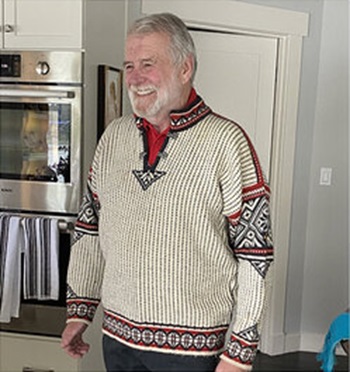 Bud was born on February 13, 1947, to Gainhart Samuelson, Senior, and Mildred (Massey) Samuelson. A lifelong resident of Petersburg, he grew up living with his mother and siblings on Hammer Slough. Summers were spent with his father at Portage Bay, where he loved fishing and hunting and grew determined to one day run a commercial fishing vessel of his own and to be a good provider for his family. After graduating from Petersburg High School in 1965, Bud landed a job on Andy Wikan’s boat, crabbing, longlining and seining aboard the wooden fishing vessel Pacific Sea. Before long, his dream future began to clarify around the captain’s lovely daughter, Audrey Wikan. Determined to impress, Bud’s fishing career accelerated until he was crabbing, seining, tendering and longlining throughout Southeast Alaska, the Gulf of Alaska, and the Bering Sea. more, >>CLICK TO READ<< 20:23
Bud was born on February 13, 1947, to Gainhart Samuelson, Senior, and Mildred (Massey) Samuelson. A lifelong resident of Petersburg, he grew up living with his mother and siblings on Hammer Slough. Summers were spent with his father at Portage Bay, where he loved fishing and hunting and grew determined to one day run a commercial fishing vessel of his own and to be a good provider for his family. After graduating from Petersburg High School in 1965, Bud landed a job on Andy Wikan’s boat, crabbing, longlining and seining aboard the wooden fishing vessel Pacific Sea. Before long, his dream future began to clarify around the captain’s lovely daughter, Audrey Wikan. Determined to impress, Bud’s fishing career accelerated until he was crabbing, seining, tendering and longlining throughout Southeast Alaska, the Gulf of Alaska, and the Bering Sea. more, >>CLICK TO READ<< 20:23
NOAA Fisheries Denies Request for Emergency Action on Bering Sea Chinook Salmon Bycatch
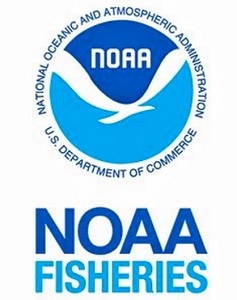 NOAA Fisheries denied a request for emergency action to institute a cap of zero on Chinook salmon bycatch in the Bering Sea pollock fishery. The request was submitted on January 17, 2024. It effectively asked Secretary of Commerce Gina Raimondo to close the Bering Sea pollock fishery, which opened on January 20, 2024. It was submitted by: Association of Village Council Presidents, Kuskokwim River Inter-Tribal Fish Commission, Tanana Chiefs Conference, Yukon River Drainage Fisheries Association, Yukon River Inter-Tribal Fish Commission. The petition also requested that the Department of Commerce urge the North Pacific Fishery Management Council to evaluate and update current Chinook salmon bycatch management. more, >>CLICK TO READ<< 13:08
NOAA Fisheries denied a request for emergency action to institute a cap of zero on Chinook salmon bycatch in the Bering Sea pollock fishery. The request was submitted on January 17, 2024. It effectively asked Secretary of Commerce Gina Raimondo to close the Bering Sea pollock fishery, which opened on January 20, 2024. It was submitted by: Association of Village Council Presidents, Kuskokwim River Inter-Tribal Fish Commission, Tanana Chiefs Conference, Yukon River Drainage Fisheries Association, Yukon River Inter-Tribal Fish Commission. The petition also requested that the Department of Commerce urge the North Pacific Fishery Management Council to evaluate and update current Chinook salmon bycatch management. more, >>CLICK TO READ<< 13:08
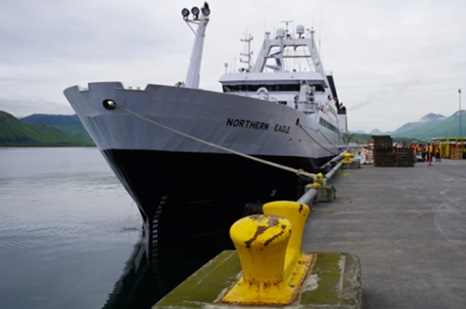
Fishery council seeks more information before deciding on chum bycatch in Bering Sea pollock fishery
The North Pacific Fishery Management Council, which manages federal fisheries in Alaska, will continue to explore options for how to manage chum salmon bycatch in the Bering Sea pollock fishery. The council, facing rising pressure from western Alaska communities who depend on chum as a cornerstone of subsistence, released a statement Wednesday summarizing their decision from their April meeting. Dismal western Alaska salmon returns have reached crisis levels. And while the council listened to scores of harrowing testimonies recalling empty rivers and vacant fish camps, the council was also presented with research that suggested bycatch limits wouldn’t do much to help the crisis. “Available science indicates recent declines in chum salmon populations across many regions of the North Pacific, including Canada, Japan, Russia, Korea, and the U.S., appear to be driven by warmer water temperatures in both the marine and freshwater environments,” the council said in the statement. more, >>click to read<< 12:38
Ecosystem reports show continuing effects of warming in Alaska’s marine waters
 The waters off Alaska’s Aleutian Islands registered the warmest winter temperatures in over a century, part of a decade-long period of warming, according to a report issued by the National Oceanic and Atmospheric Administration. The Aleutians report is one of three annual ecosystem status reports issued by NOAA Fisheries for marine areas of Alaska. The reports, compiled by large teams of scientists, were released earlier this month and presented to the North Pacific Fishery Management Council, the panel that sets regulated commercial fishing in federal waters off Alaska. The Bering Sea remains warmer than the long-term average, though it has cooled since the heatwaves, NOAA Fisheries biologist Elizabeth Siddon told the North Pacific Fishery Management Council in her presentation of the report. more, >>click to read<< 07:53
The waters off Alaska’s Aleutian Islands registered the warmest winter temperatures in over a century, part of a decade-long period of warming, according to a report issued by the National Oceanic and Atmospheric Administration. The Aleutians report is one of three annual ecosystem status reports issued by NOAA Fisheries for marine areas of Alaska. The reports, compiled by large teams of scientists, were released earlier this month and presented to the North Pacific Fishery Management Council, the panel that sets regulated commercial fishing in federal waters off Alaska. The Bering Sea remains warmer than the long-term average, though it has cooled since the heatwaves, NOAA Fisheries biologist Elizabeth Siddon told the North Pacific Fishery Management Council in her presentation of the report. more, >>click to read<< 07:53
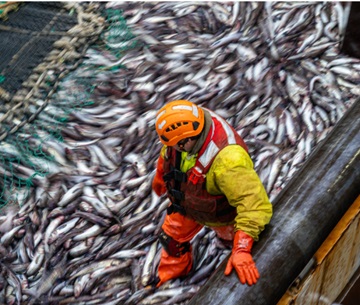
Alaska pollock trawlers are feeling pressure over salmon bycatch, so this reporter went to see for himself
Bering Sea factory trawlers scoop up tens of thousands of pollock at a time, and pressure is intensifying to avoid catching salmon as populations of chum and chinook have plummeted in recent years, causing closures for subsistence harvesting. The trawlers are not entirely to blame, warming oceans due to human-caused climate change are almost certainly a factor, but they have drawn the ire of salmon advocates from Western Alaska to Washington D.C. This is a 341-foot vessel that I went out on, the Northern Hawk, with a crew of 129 people. And most of them work below the deck in a fish factory that, basically when the fishing is reasonable, operates 24 hours a day. Then there are these incredible fillet machines that will fillet 180 fish a minute, and the job of the human is basically to just feed the machine 24 hours a day. And it’s kind of mind-numbing work. Your hands move constantly to make sure the fish are positioned correctly. >>click to read<< 07:40
Alaska fishermen will be allowed to harvest lucrative red king crab in the Bering Sea
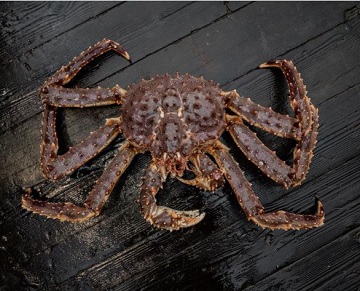 Alaska fishermen will be able to harvest red king crab for the first time in two years, offering a slight reprieve to the beleaguered fishery beset by low numbers likely exacerbated by climate change. There was no such rebound for snow crab, however, and that fishery will remain closed for a second straight year, the Alaska Department of Fish and Game announced Friday. “The Bristol Bay red king crab fishery for the prior two seasons were closed based on low abundance and particularly low abundance of mature-sized female crabs,” said Mark Stichert, the state department’s ground fish and shellfish management coordinator, “Based on survey results from this year, those numbers have improved, some signs of modest optimism in terms of improving abundance in Bristol Bay red king crab overall and that has allowed for a small but still conservative fishery for 2023 as the total population size is still quite low,” he said. >>click to read<<11:52
Alaska fishermen will be able to harvest red king crab for the first time in two years, offering a slight reprieve to the beleaguered fishery beset by low numbers likely exacerbated by climate change. There was no such rebound for snow crab, however, and that fishery will remain closed for a second straight year, the Alaska Department of Fish and Game announced Friday. “The Bristol Bay red king crab fishery for the prior two seasons were closed based on low abundance and particularly low abundance of mature-sized female crabs,” said Mark Stichert, the state department’s ground fish and shellfish management coordinator, “Based on survey results from this year, those numbers have improved, some signs of modest optimism in terms of improving abundance in Bristol Bay red king crab overall and that has allowed for a small but still conservative fishery for 2023 as the total population size is still quite low,” he said. >>click to read<<11:52
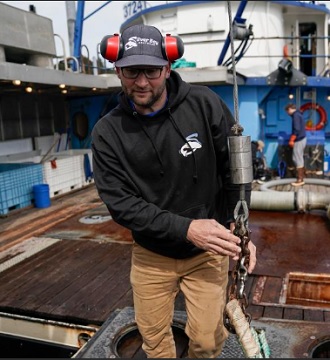
Alaskan fishers fear another bleak season as crab populations dwindle in warming waters
Gabriel Prout worked four seasons on his father’s crab boat, the Silver Spray, before joining his two brothers in 2020 to buy a half-interest plus access rights for a snow crab fishery that’s typically the largest and richest in the Bering Sea. Then in 2021, disaster: an annual survey found crabs crashing to an all-time low. Kevin Abena, who runs a fishing business with his father, also relies on tendering to stay afloat in the wake of the crab fishery closure. His vessel Big Blue, which his father built in the late 1970s, stopped fishing for most crab in Bristol Bay in 2010, but they still own access rights and take a percentage from other boats that fish their quota. Abena also fishes for halibut and black cod.>>click to read<< 12:31
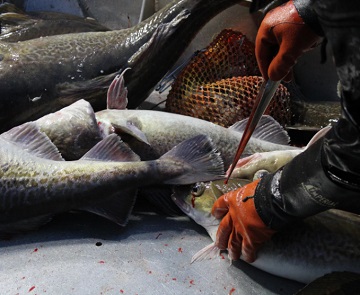
Catch Shares: Commercial trawlers to transition to quota system for Bering Sea and Aleutian Islands cod harvests
Starting in January, the fleet will fish under a “rationalization” system where each catcher vessel will have a maximum catch limit, which will be assigned through quota. The new regulations will require vessels trawling for cod in the area to form cooperatives, and quota will be administered through each co-op. Previously, the entire fishery had a total allowable catch that had to be caught within a certain amount of time. NOAA said this is the first time a catch share program has been implemented in Alaska since 2012. >>click to read<< 09:31

Western Alaska: Crab are looking healthy after downturn in 2019
The region is known for its abundant crab populations and supports several species. Ten species of crab are caught throughout fisheries in the state, seven of them having commercial importance. According to the Alaska Fish and Game (ADF&G) website, the Bering Sea, Aleutian Islands, and the Gulf of Alaska combined produce approximately 1/3 or more of total crab catches in the United States. The season for commercial crabbing is dependent on when they open, and how fast the guideline harvest limit (GHL) is caught. The harvest data from this season and the trawl survey are put into the model. >click to read< 12:57

Linda Greenlaw’s Favorite Maine Place
It was while piloting a tour a few years back that she found her favorite Maine place, a little cove on the eastern side of Morgan Bay that she appreciates for its quietude. These days, whenever she has time, she likes to hike to the cove at low tide to go clamming. . She considers herself retired from chasing swordfish, but when pressed, she takes a “never say never” stance on someday unretiring. “Swordfish are alive and colorful when they come on board,” she says. “With their big bills, it’s like catching unicorns.” Last fall, she flew to Alaska to join the cast of season 19 of Discovery Channel’s Deadliest Catch, a series that follows the day-to-day dramas of crab-fishing crews on the Bering Sea. >click to read< 20:26
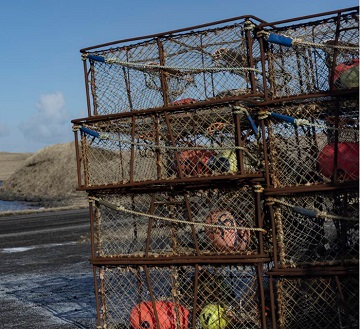
The snow crab vanishes
My small turboprop plane whirred low through thick clouds. Below me, St. Paul Island cut a golden, angular shape in the shadow-dark Bering Sea. I saw a lone island village — a grid of houses, a small harbor, and a road that followed a black ribbon of coast. Some 330 people, most of them Indigenous, live in the village of St. Paul, about 800 miles west of Anchorage, where the local economy depends almost entirely on the commercial snow crab business. Over the last few years, 10 billion snow crabs have unexpectedly vanished from the Bering Sea. I was traveling there to find out what the villagers might do next. Photos, >click to read< 15:54

Crab pots ‘absolutely stuffed’ as Bering Sea Dungeness fishery breaks records
While many Bering Sea crab populations are in freefall, Dungeness crab is breaking records in regions that hardly used to see them. The North Peninsula District in the eastern Bering Sea opened as a commercial Dungeness fishery in the early ‘90s. In those early days, it was common for just one or two boats to fish there — many seasons, there were none. The numbers increased modestly over the ensuing decades — but that growth has recently become exponential. “The pots that we’re seeing coming out of this fishery are absolutely stuffed with crab,” said Ethan Nichols, who works for the Alaska Department of Fish and Game. “Like, you don’t even know how many crabs can fit in a pot.” >click to read< 20:43
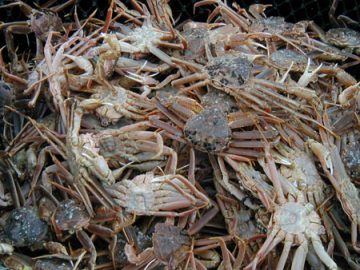
Disaster aid has arrived, but Western Alaska’s salmon and crab problems continue
The Alaska congressional delegation announced on Friday that the U.S. Commerce Department released the disaster aid. The money is to go to harvesters, processors and communities affected by designated disasters in salmon and crab fisheries that occurred between 2020 and 2022. For Bering Sea snow crab, signs are that the problems that led to the first-ever harvest closure, which was announced last October, will last for years. The National Oceanic and Atmospheric Administration Fisheries Service 2022 survey found that despite the emergence of cooler and more normal temperatures, mature male snow crab abundance was the lowest on record and mature female snow crab abundance was the third lowest on record. >click to read< 10:12

‘A’ season pollock quota back on par after decrease last season
Bering Sea pollock fishermen have almost met their “A” season quota. Since the fishery opened in late January, nearly 100 vessels have caught about 1.2 billion pounds of Alaska pollock. That leaves about 43 million pounds still available to catch. “It’s definitely a lot of fish,” said Krista Milani, a fisheries resources management specialist with the National Oceanic and Atmospheric Administration in Unalaska. “Sometimes when you think about the amount of pollock that they’re able to sustain in the Bering Sea, it’s kind of mind-blowing how much pollock is actually there.” According to NOAA, fishery managers were dealing with data gaps stemming from the COVID-19 pandemic. A population survey also came back lower than expected. “A” season ends June 10 — the same day “B” season starts. >click to read< 11:04
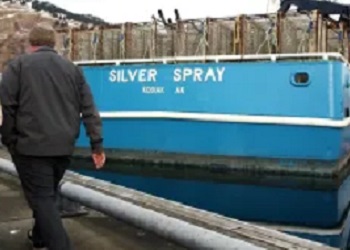
10 billion snow crabs disappeared from the Bering Sea. Scientists and fishermen are working together to understand why
The snow crabs’ population in the Bering Sea off the western coast of Alaska has fluctuated for decades. An increase in young crabs back in 2018 gave way to optimism that fishing would be good for years to come, but the hope was short-lived. Gabriel Prout and his family own the fishing vessel Silver Spray in Kodiak, Alaska. He said it was obvious something was wrong the last few years. The Bering Sea fishing grounds are usually covered in sea ice in the winter. But there wasn’t much ice, and they fished further north than usual. Finding snow crabs was still difficult. “It was just very poor fishing,” said Prout. “We searched for miles and miles and miles and really didn’t see anything.” >click to read< 10:15
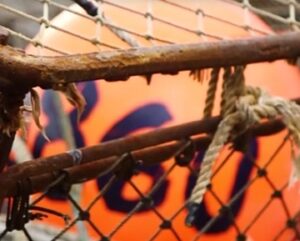
Understanding the Bering Sea snow crab collapse
The Bering Sea snow crab season was canceled this year after billions of crabs disappeared – devastating a commercial fishing industry worth $200 million dollars and the livelihoods of those who depend on it. Now, fishermen and researchers are working to figure out what happened. On this Alaska Insight, host Lori Townsend is joined by Gabriel Prout, a crab fisherman and owner of the F/V Silver Spray, and Erin Fedewa, a fisheries biologist with the federal government, to discuss the impacts and potential causes of the crash. Video, >click to watch< 10:56
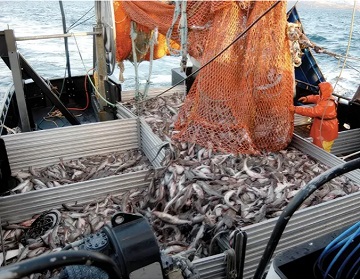
Solutions to the Bycatch Blame Game
The issue of bycatch has grown more important as some fisheries get smaller and those who depend on the fish for their livelihood or survival find that there are not enough fish to go around. This raises the question of whether bycatch is at the root of the problem or if other issues facing fisheries must be addressed. Bycatch is monitored in a combination of ways, through at-sea observers, electronic monitoring, seafood processing plant observers, logbooks, and fish tickets. “In the Bering Sea, approximately 94 percent of all catch is observed, including 99 percent of all trawl catch,” Bush explains. “In the Gulf of Alaska, 40 to 50 percent of all catch is observed across all gear types.” Photos, >click to read< 12:26
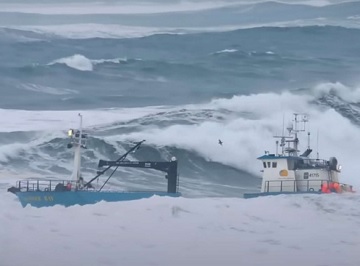
The Deadliest Catch and Other Crab Fishermen Need to Find a New Alaskan Spot Thanks to Climate Change
Even if you’ve only been a fan of Discovery’s “Deadliest Catch” for a short period of time, it’s still pretty obvious that the list of essential steps needed for the featured captains and boats to rake in a season’s worth of seafood remains consistent. On top of a meticulously maintained boat, needed are traps, bait, backup equipment, a solid crew, and more than a handful of other necessities. Of course, the most important detail is the one thing these brave fishermen are there for in the first place, and that’s the crab itself. However, due to climate change, the fishing industry on the Bering Sea has been flipped on its head. >click to read< 11:31
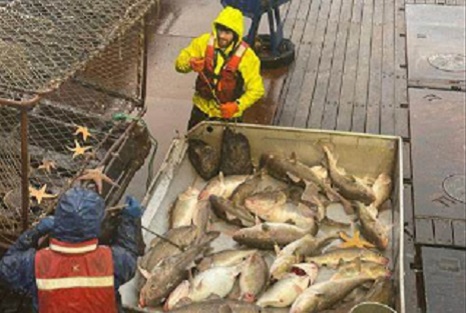
The Informal Strike. Bering Sea cod fisherman fight for better catch price
The Bristol Bay red king crab fishery has been closed for two years, and along with it, Bering Sea snow crab have abruptly disappeared, So when a group of Bering Sea fishermen recently heard they’d be getting paid less than they hoped for cod this winter season, they figured they couldn’t afford to just sit by. But that’s exactly what they did. Rather than head out right away to the fishing grounds and set their gear like they usually do on the New Year, nearly 30 boats dropped their anchors or docked up in port, waiting on better news. “Trident posted a substantially low price for cod this season, but no other processors would post anything,” said Chris Studeman, captain and co-owner of the 104-foot fishing vessel Kevleen K. “And they all expected us to just go fishing with the good faith that they’ll make it right in the end. And you can’t really run an operation with the hope that somebody will make it right in the end.” >click to read< 20:49
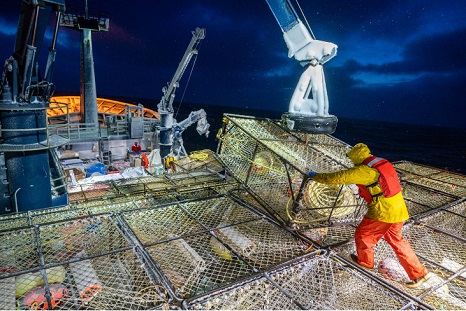
Bering Sea crab collapse spurs push for stronger conservation measures
For Bering Sea crabber Gretar Gudmundsson, December is a month for preparing his two boats for the winter harvest season. But not this year. For the first time, the winter snow crab season has been scuttled. The move has upended seasonal rhythms, and the financial stability of a crab fleet already slammed by a two-year shutdown of the fall harvest of red king crab. “We didn’t ship up any groceries. We didn’t recruit any crew. We’re not laying on fuel. Nothing is happening,” Gudmundsson said. Crabbers are pressing for more restrictions on pollock fleets, which deploy large cone-shaped trawl nets to scoop up more than 3.2 billion pounds annually of this fish in the biggest single-species harvest in North America. >click to read< 11:55
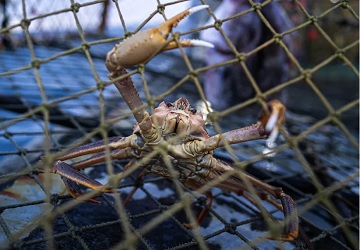
Decline of Bering Sea snow crab fishery demands swift action
Billions of crabs have vanished off the coast of Alaska, and with them, the fishing season for the Bering Sea crab fleet. This is grim news for a fleet that has fished crabs under science-based catch limits for years, providing healthy wild-caught seafood to the world and bringing jobs and income throughout Alaska and the Pacific Northwest. It’s also bad news for the communities of the Bering Sea, like St. Paul Island, where the economy is almost entirely dependent on the snow crab fishery. >click to read< 20:44






